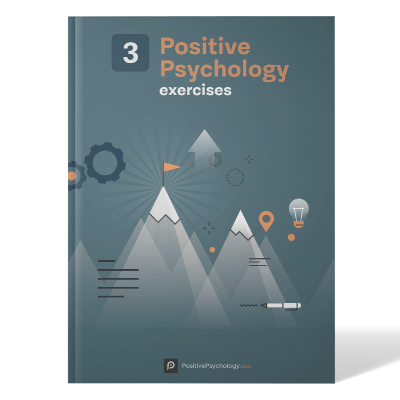11 Optimism Exercises & Theories (Incl. Learned Optimism)
 A popular metaphor to explain optimism is the concept of ”glass half full.”
A popular metaphor to explain optimism is the concept of ”glass half full.”
Optimists have a built-in attitude to be hopeful and consider the possibilities of good things happening in life.
The word “optimism” comes from the Latin word optimum, meaning “the best.” In psychology, optimism or dispositional optimism is a set of beliefs and traits that help individuals reflect on the positive aspects of life rather than the negative ones. It is a personality pattern that displays resilience and personal strength.
Optimism is all about how we perceive things. Consider the following example:
A and B are two individuals of the same age and background. Both of them are undergoing stressful separations from their respective long-term marital relationships. The emotional turmoil has completely shattered both these people equally. However, B decides to focus on their career and tries to move on in life. On the other hand, A gets emotionally stuck and fails to foresee any good things that might ever happen to them after this.
Clearly, in this instance, B is more optimistic than A, even though they are undergoing similar circumstances in life. Optimism is essentially a mindset – the way we shape our thoughts and choose to attend to them decides how positively we can address our troubles.
Inculcating optimism, no matter how difficult it may seem, is a prime focus of contemporary person-centered psychotherapy. This article highlights some of the best optimism tools and activities that we can use to instill hope and cultivate a positive outlook within ourselves, people we live with, or our clients.
Before you continue, we thought you might like to download our three Emotional Intelligence Exercises for free. These science-based exercises will not only enhance your ability to understand and work with your emotions but will also give you the tools to foster the emotional intelligence of your clients, students, or employees.
This Article Contains:
A Look at Optimism Theory
Research on the dynamics of optimism has fascinated psychologists and mental health workers for a long time. There are two fundamental models or approaches that explain optimistic personality: the dispositional model and the explanatory model.
The dispositional theory of optimism
The dispositional model of optimism was the first wave of research that explored the impact of hopefulness on a better lifestyle and mental health. Psychologists following this approach highlighted optimism as a crucial aspect of humans’ success in evolution (Segerstrom, 2006).
Carver and Scheier (1987) introduced the term “dispositional optimism.” They argued that it is the presence of positive traits that increases the chances of something good happening to us. The dispositional theory of optimism suggests that optimism leads to positive consequences in life, and pessimism leads to stressful outcomes and increased dissatisfaction (Scheier & Carver 1987, Scheier et al., 2001).
The basic tenets of the dispositional theory of optimism are (Chang, 2001):
- Optimism is a built-in trait or personality disposition.
- Optimism is directly associated with reduced depression, anxiety, and stress.
- Optimistic individuals are overall healthy – both physically and emotionally.
- Optimism calls for increased resilience and coping strategies.
- A positive outlook helps people to accept themselves unconditionally. Optimistic individuals are less likely to engage in denial or avoidance defense mechanisms.
The explanatory model of optimism
Martin Seligman derived the explanatory model of optimism from his famous concept of “learned helplessness.” This approach explains optimism as the way people perceive and interpret events more than their built-in personal traits.
According to the explanatory theory of optimism, people who perceive failure or stressful life events as personal shortcomings are pessimists. Optimism, as Seligman explained, is the cognitive ability to understand the current situation as it is and work to change things in our favor (Buchanan & Seligman, 1995).
5 Examples of Using Optimism in Therapy

Optimism in psychotherapy is practiced in different forms, including empathetic communication, group activities, role-play, objective tests, and situational games.
Any psychological condition that accompanies negative thinking and unbearable distress can be the right place for using optimistic interventions. Some examples where optimism is used as a psychotherapeutic conjunct are:
- Major depression that exists independently or as an aggravation from bipolar syndrome.
- Postpartum depression, a condition new mothers often experience. While the causes of postpartum depression may be physiological or hormonal imbalances, using cognitive measures for boosting optimism helps clients regain their inner strength.
- Post-traumatic stress disorders, especially cases of sexual violence and domestic abuse.
- Bereavement and loss of close ones.
- Terminal illnesses such as cancer and allied problems like hair loss.
Recent studies on the effect of optimism on victims of natural disasters found out that clients who received positive interventions could cope better with their situation (Van der Velden et al. 2007).
How to Encourage Optimism in Kids

Helping kids overcome negative thoughts from an early age can go a long way in making them self-reliant hopeful individuals in the future.
In his book ‘Learned Optimism: How to Change Your Mind and Your Life,’ Martin Seligman (1991) mentioned three benefits of making children optimistic:
- It calls for better health.
- Optimism implies better academic and extracurricular performance.
- It builds resilience and strength to sail through tough times.
To encourage kids to think better of themselves and their lives, here are some strategies parents, teachers, and counselors can use.
Optimistic self-talk
Modeling positive self-talk is a great way to promote optimism in kids. For example, parents can talk about their day at work and invite kids to share about their day at school.
Exchanging simple thoughts about what they liked about today, what made them feel bad, and how they are planning to make the most of the next day can be a simple yet powerful start to cultivating positive thinking in a child.
Empathy
Empathy begins with acknowledging the child’s feelings. Children who feel heard and attended at home usually grow up to become conscious and empathetic individuals.
Parents and teachers can use simple statements such as ‘I can understand how you feel,’ or ‘ I would have felt the same if I were you’ to model empathetic behavior.
Learning how to empathize teaches a child to understand, accept, and reflect the same during stressful times later.
Focus on effort rather than results
Seligman (1991) stressed the role of the right attitude in building optimism. Positive thinkers focus more on the process than the results. For example, encouraging children to participate in activities without worrying about who wins and who loses is a great message for nurturing this faith.
Parents who appreciate children for their efforts are encouraging those kids to believe in themselves and never stop trying.
Recalling happier times
Negative thinking may drive a child to believe that bad times never end. As caregivers or counselors, we can motivate them to recall past experiences, that made them sad initially but they could later overcome it.
Asking questions such as “How did you feel when you got a better outcome than you expected?” can help them introspect and find hope from within.
Changing perspective
A shift from negative to positive perspective can be both the cause and the consequence of optimism. Helping children understand that it is practically impossible to always have things the way we want is a significant step to make them insightful.
Once they learn to manage their expectations and look into any matter with rational reasoning, they may more easily tune in to their optimistic self.
Can We Test and Assess Optimism?
Assessments of optimism have stemmed from two main perspectives:
- The expectancy perspective has tests that focus on the expectations we have from ourselves and our future.
- The attributional perspective has optimism tests measuring individual habits and actions that shape their perception.
Let us have a look at some of the popular assessments of optimism that are widely used in mental health today. We will talk about both the perspectives of optimistic interventions to help you choose what is best for you.
2 Optimism Tests and Questionnaires
How optimistic are you? Try these tests.
The Learned Optimism Test
The Learned Optimism Test is an adaptation from Seligman’s works.
It is a self-report questionnaire with 48 questions of hypothetical life situations. Each item has two possible responses.
The instructions of the Learned Optimism Test mention that there are no right or wrong answers involved here and the results are relative measurements of how optimistic a person generally feels. Below is a brief overview of the test.
| Questions | Check the response that you think describes you the best | |
|---|---|---|
| Response 1 | Response 2 | |
| You and your partner resolve a nasty fight. | It is because you forgave them this time. | It is because you are generally forgiving. |
| Your partner surprises you with a nice gift. | It might be because they just got a salary hike. | It is because you gave them something the other day. |
| You get flowers from a secret lover. | It is because that person finds you attractive. | It is because you are a popular person. |
| You get lost while driving to your friend. | It is because you missed the turn. | It is because your friend didn’t give the right directions. |
| You were at the peak of your health this year. | It is because you were around other healthy people. | It is because you took good care of yourself. |
Optimism Test
The Optimism Test is a short online self-assessment that gives an accurate score of a person’s Optimism Quotient. The questionnaire contains 10 questions on a four-point scale. The summation of the scores provides an estimate of how optimistic or pessimistic the person is.
The scores are interpreted in three categories, as shown below:
- 0 – 40 -> Less optimistic
- 40 – 80 -> Moderately optimistic
- 80 and above -> Highly optimistic
Here is a brief snippet of the form. You can take the full test, as well.
1. Household chores to you are:
|
2. In the morning, you wake up feeling:
|
3. Your views about your work are:
|
4. Your objective in life is:
|
5. Neighbors to you are:
|
2 Activities and Exercises (incl. PDF)
Now that we know how optimistic you are, try out these exercises.
Tapping Into Your Inner Optimist
This activity primarily concentrates on the difference between positive thinking and negative thinking.
The participants in this practice move between two chairs and embody their pessimistic and optimistic selves each time. The exercise administrator asks situational questions and requests the respondents to imagine themselves thinking negatively and positively.
As the respondents switch from optimistic to pessimistic thoughts, they change position between the two chairs. At the end of the session, the respondents come up with their experiences of positive and negative thinking and evaluate which pattern of thought made them feel better.
Realistic Optimism
Realistic Optimism was a part of the Umbrella Project, a popular emotional awareness program for schoolchildren. It is a set of activities aimed at increasing awareness about positive thinking and optimism among young respondents.
Exercises in this program include:
- Sharing valuable inputs on the meaning of realistic optimism and why it matters to us.
- Exchanging personal experiences of dealing with a problematic situation with positivity.
- Showing videos explaining optimism in real life.
- Helping students to imagine themselves being realistically optimistic and writing their views in a journal.
- Group activities of role-play and role modeling with optimism as the key takeaway.
You can learn more about these exercises here.
2 Useful Worksheets

Creating an Optimistic Mindset Worksheet
This worksheet was introduced as a positive intervention in emotional resilience training and became a popular measure for optimism in mental health and psychotherapy as well.
The sheet is straightforward and provides meaningful insight into how the respondents generally feel about their life experiences.
Participants, at first, think about good and unfortunate incidents that recently happened to them. Then they go ahead to answer the questions in the worksheet and choose an option that they think is most appropriate.
The answers provide an appropriate direction as to whether the person tends to think optimistically or not. It is excellent for self-motivated individuals who wish to become more positive in their outlook and take life one day at a time.
Below is a brief overview of the test.
Part 1 – Think of a negative incident that recently happened to you and answer the following questions.
Was the incident the result of:
- Your inability (pessimist)
- External factors (optimist)
How did the incident make you feel?
- More negative things will happen to me (pessimist)
- This is a one-time occurrence (optimist)
What does this negative incident mean?
- More bad things are coming to me in other areas of life (Pessimist)
- This is a temporary setback (Optimist)
Part 2 – Think of a positive experience that recently happened to you and answer the following questions.
Why did the event happen?
- Because of my abilities (optimist)
- Due to external factors (pessimist)
What does it imply?
- More positive things can happen in life (optimist)
- This is a one-time fluke (pessimist)
This incident proves that:
- More success awaits in the future (optimist)
- This happened by chance and would never happen again (pessimist)
Seligman’s Worksheet on Learned Optimism
This worksheet is based on Martin Seligman’s (1991) work on learned optimism and follows the classical A-B-C-D-E model of creating a positive mindset. The A-B-C-D-E is an acronym for:
A – Adversity or paying attention to any adverse incidents, thoughts, and feelings.
B – Beliefs and how they are impacted by pessimistic thoughts.
C – Consequences of negative thoughts and feelings.
D – Dispute or confronting the negative thoughts and attempting to change them.
E – Energizing the self to be more optimistic in the future.
Seligman’s worksheet contains several situational examples and scenario tests, all of which follow the A-B-C-D-E model. The exercise helps participants challenge their pessimistic selves and become positive thinkers. You can learn more about this exercise.
A Take-Home Message
Embracing optimism doesn’t make us immune to stress and worries. Optimism teaches us how to see what is going wrong and still be hopeful that it can be turned right.
As a positive psychology intervention, optimism partly helps in building resilience, teaches us radical acceptance, and motivates in the form of hope to keep going. The tools and exercises mentioned above can be the starting point of knowing why we feel negative and what measures we can take to instill optimism within us.
[Reviewer’s Note: I’m not sure that optimism can be used as a psychotherapeutic conjunct.]
We hope you enjoyed reading this article. Don’t forget to download our three Emotional Intelligence Exercises for free.
- Buchanan, G. M., & Seligman, M. E. P. (Eds.). (1995). Explanatory style. Erlbaum.
- Chang, E. (2001). Optimism & Pessimism: Implications for Theory, Research, and Practice. American Psychological Association.
- Scheier, M. F., & Carver, C. S. (1987). “Dispositional optimism and physical well-being: the influence of generalized outcome expectancies on health”. Journal of Personality. 55 (2): 169–210.
- Scheier, M. F., Carver, C. S., & Bridges, M. W. (2001). Optimism, pessimism, and psychological well-being. In. E. C. Chang (Ed.), Optimism & pessimism: Implications for theory, research, and practice (pp. 189–216). American Psychological Association.
- Segerstrom, S. C. (2005) Optimism and immunity: do positive thoughts always lead to positive effects? Brain, Behaviour & Immunity. 19(3):195–200.
- Seligman, M. E. P. (1991). Learned optimism. Knopf.
- van der Velden, P. G., Kleber, R. J., Fournier, M., Grievink, L., Drogendijk, A., & Gersons, B. P. R. (2007). The association between dispositional optimism and mental health problems among disaster victims and a comparison group: A prospective study. Journal of Affective Disorders, 102(1–3), 35–45.
Let us know your thoughts
Read other articles by their category
- Body & Brain (41)
- Coaching & Application (49)
- Compassion (27)
- Counseling (46)
- Emotional Intelligence (23)
- Gratitude (16)
- Grief & Bereavement (19)
- Happiness & SWB (35)
- Meaning & Values (26)
- Meditation (21)
- Mindfulness (42)
- Motivation & Goals (42)
- Optimism & Mindset (33)
- Positive CBT (24)
- Positive Communication (21)
- Positive Education (41)
- Positive Emotions (28)
- Positive Psychology (33)
- Positive Workplace (38)
- Relationships (31)
- Resilience & Coping (33)
- Self Awareness (21)
- Self Esteem (38)
- Software & Apps (23)
- Strengths & Virtues (28)
- Stress & Burnout Prevention (27)
- Theory & Books (42)
- Therapy Exercises (30)
- Types of Therapy (53)





What our readers think
Thank you profusely for this hard work and excellently compiled article and resources! I use it in my classes and it is all positively received always.
Grateful and thankful for you!
Flo Norris, M.S.
Professor of Psychology
Much Needed, Thanks
Nice article. Was looking for something like this. Thanks
Thanks a lot Ms. Roy. Awaiting to have session with my audience on this theme. Just loved it.
Hi Jazmine,
So glad you found these exercises helpful. Best of luck delivering your session.
– Nicole | Community Manager
Lovely article and very useful. Got my mind ticking on how to use it. Thank you!
Great article. Very useful lessons. Thanks for the good work!